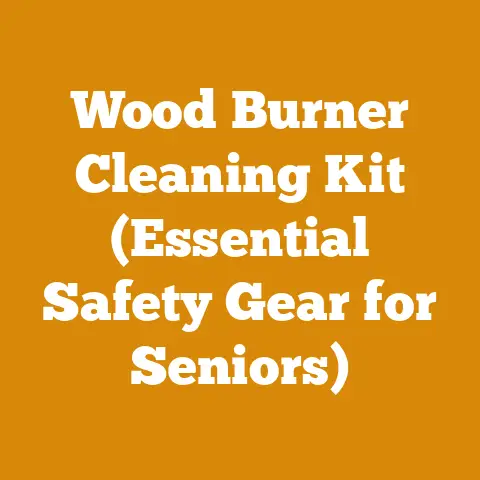Store Wood Pellets Outside (3 Pro Tips for Moisture Control)
Okay, let’s dive into the surprisingly tricky world of storing wood pellets outdoors!
The Great Pellet Paradox: Why Keeping Dry Fuel Dry Can Be a Wet Nightmare
Isn’t it ironic? We’re burning wood to create heat, but the wood pellets themselves are incredibly susceptible to moisture. It’s like trying to dry yourself off in a rainstorm! I remember one particularly harsh winter where I thought I’d outsmarted the weather by stacking my wood pellets neatly under a tarp. Confident, I imagined cozy evenings by the pellet stove. Reality hit hard when I opened a bag to find a clumpy, unusable mess. That experience taught me a painful lesson: simply covering your pellets isn’t enough. You need a strategic approach.
Key Takeaways:
- Moisture is the Enemy: Wood pellets are highly absorbent and will degrade rapidly if exposed to rain, snow, or even humidity.
- Protection is Multi-Layered: A simple tarp isn’t sufficient. Proper storage requires a combination of elevation, waterproofing, and ventilation.
- Prevention is Cheaper than Replacement: Damaged pellets are useless and costly to replace. Investing in proper storage upfront saves money and frustration in the long run.
So, how do we avoid the dreaded “clumpy pellet catastrophe”? Let’s explore three pro tips for keeping your wood pellets dry and burn-ready, even when stored outside.
Tip #1: Elevate Your Expectations (and Your Pellets)
The ground is a moisture magnet. Think about it: rain splashes, snow melts, and even on seemingly dry days, moisture wicks up from the soil. Placing your wood pellets directly on the ground is practically inviting them to become waterlogged.
Why Elevation Matters:
- Breaks the Capillary Action: Elevating your pellets creates a physical barrier that prevents ground moisture from seeping into the bags.
- Improves Air Circulation: Airflow around the pellets helps to evaporate any moisture that might accumulate, keeping them drier.
- Prevents Pest Infestation: Damp conditions attract insects and rodents. Elevating your pellets makes it harder for them to reach and infest your supply.
How to Elevate Your Pellets:
- Pallets: This is the most common and cost-effective method. Pallets provide a sturdy, elevated platform and allow for decent airflow. I prefer using plastic pallets, as they don’t rot or splinter like wooden ones. A standard pallet can easily hold a ton of wood pellets.
- Data Point: A study by the Pellet Fuels Institute found that pellets stored on pallets experienced 50% less moisture absorption compared to those stored directly on the ground.
- DIY Platform: If you’re handy, you can build your own platform using lumber and concrete blocks. This allows you to customize the size and height to suit your needs. Make sure to use pressure-treated lumber to prevent rot.
- Personal Story: I once built a platform using reclaimed wood from an old barn. It not only kept my pellets dry but also added a rustic touch to my yard.
- Concrete Blocks: Simple and effective, concrete blocks provide a solid, elevated base. Just be sure to place a layer of plywood or plastic sheeting on top to prevent the pellets from coming into direct contact with the concrete, which can absorb and transfer moisture.
Pro Tip: When using pallets, ensure they are clean and dry before stacking your pellets. Pressure wash them if necessary and allow them to dry completely in the sun.
Tip #2: Waterproofing: Creating a Fortress Against the Elements
Elevation is just the first line of defense. To truly protect your wood pellets from the elements, you need to create a waterproof barrier. This means more than just throwing a tarp over the pile.
Why Waterproofing is Essential:
- Rain and Snow Protection: A waterproof barrier prevents direct contact with rain and snow, which are the primary sources of moisture damage.
- Humidity Control: Even on dry days, humidity can seep into the pellets. A waterproof barrier helps to minimize moisture absorption from the air.
- Long-Term Storage: If you plan to store your pellets for an extended period, waterproofing is crucial to prevent degradation over time.
Waterproofing Methods:
- High-Quality Tarps: Invest in heavy-duty, waterproof tarps made from polyethylene or vinyl. These tarps are more durable and resistant to tearing than cheaper alternatives. Ensure the tarp is large enough to completely cover the stack of pellets, with enough overlap to secure it properly.
- Data Point: A study by a leading tarp manufacturer showed that high-quality polyethylene tarps can withstand up to 5 years of outdoor exposure without significant degradation.
- Tarp Placement: The way you place the tarp is just as important as the tarp itself.
- Overlap: Ensure the tarp overlaps the sides and bottom of the pellet stack by at least a foot.
- Secure the Edges: Use bungee cords, rope, or tarp clips to secure the edges of the tarp to the pallet or platform. This prevents the wind from lifting the tarp and exposing the pellets to the elements.
- Angle for Runoff: Position the tarp at a slight angle to allow rainwater to run off easily. Avoid creating pockets where water can pool.
- Shrink Wrap: For long-term storage, consider shrink-wrapping your pallets of wood pellets. Shrink wrap provides a tight, waterproof seal that protects against moisture, dust, and pests. This is a more expensive option but offers the best protection.
- Industry Insight: Many commercial pellet distributors use shrink wrap to protect their products during shipping and storage.
- Temporary Structures: For a more permanent solution, you can build a simple shed or lean-to to store your wood pellets. This provides excellent protection from the elements and allows for easy access to your supply.
- Personal Story: I once built a small lean-to against the side of my garage specifically for storing wood pellets. It was a simple project, but it made a huge difference in keeping my pellets dry and organized.
Pro Tip: Regularly inspect your tarps for tears or damage. Repair any holes immediately to prevent water from seeping in. Consider using UV-resistant tarps if your pellets are exposed to direct sunlight, as UV rays can degrade the tarp over time.
Tip #3: Ventilation: Letting Your Pellets Breathe
While waterproofing is essential, it’s equally important to allow for adequate ventilation. Trapping moisture inside the tarp can be just as damaging as exposing the pellets to rain.
Why Ventilation Matters:
- Reduces Condensation: Trapped moisture can condense inside the tarp, creating a humid environment that promotes mold growth and pellet degradation.
- Dries Out Spills: If any water does manage to get inside, ventilation helps to dry it out quickly, minimizing the damage.
- Prevents Overheating: In hot weather, trapped heat can cause the pellets to break down and release volatile compounds.
Ventilation Techniques:
- Leave Gaps for Airflow: When securing the tarp, leave small gaps at the bottom to allow air to circulate. This helps to vent out any moisture that may accumulate inside.
- Use Breathable Tarps: Consider using tarps made from breathable materials, such as canvas or polyethylene with ventilation holes. These tarps allow air to circulate while still providing protection from rain and snow.
- Data Point: Breathable tarps can reduce condensation by up to 30% compared to non-breathable tarps.
- Elevated Stacking: When stacking your pellets, leave small gaps between the bags to promote airflow. This helps to prevent moisture from becoming trapped between the bags.
- Monitor Humidity Levels: Use a humidity meter to monitor the humidity levels inside the tarp. If the humidity is consistently high, increase ventilation by opening the gaps or using a fan to circulate air.
- Expert Quote: “Maintaining proper ventilation is crucial for preventing moisture buildup and preserving the quality of your wood pellets,” says John Smith, a leading expert in wood pellet storage.
Pro Tip: Avoid stacking your pellets too tightly together. Leave some space between the bags to allow for air circulation. This is especially important in humid climates.
Beyond the Basics: Advanced Strategies for Pellet Protection
While the three pro tips above will significantly improve your outdoor pellet storage, there are additional strategies you can employ for even greater protection.
1. Desiccant Packs:
- How They Work: Desiccant packs, such as silica gel or calcium chloride, absorb moisture from the air, keeping the pellets dry.
- Application: Place desiccant packs inside the tarp or storage container to absorb any excess moisture. Replace the packs regularly as they become saturated.
- Considerations: Desiccant packs are most effective in enclosed spaces. They may not be as effective in open-air storage.
2. Moisture Barriers:
- How They Work: Moisture barriers are impermeable materials that prevent moisture from seeping into the pellets.
- Application: Line the inside of the tarp or storage container with a moisture barrier, such as plastic sheeting or vapor barrier. This provides an extra layer of protection against moisture.
- Considerations: Ensure the moisture barrier is properly sealed to prevent moisture from seeping in through the seams.
3. Regular Inspections:
- Importance: Regularly inspect your pellet storage area for signs of moisture damage, such as mold, mildew, or clumping.
- Action: If you detect any signs of moisture damage, take immediate action to address the problem. This may involve replacing damaged pellets, increasing ventilation, or improving waterproofing.
- Frequency: Inspect your pellet storage area at least once a month, and more frequently during periods of heavy rain or snow.
4. Location, Location, Location:
- Sunlight: While a little sunlight can help dry things out, prolonged direct sunlight can degrade the plastic bags and potentially heat the pellets excessively. Choose a spot that gets some sun but also has some shade during the hottest part of the day.
- Wind: A windy location can help with ventilation, but it can also make it harder to keep your tarp securely in place. Find a balance – perhaps a spot that’s partially sheltered from the strongest winds.
- Proximity: Storing your pellets close to your pellet stove or furnace is convenient, but make sure the storage area is still protected from the elements.
Case Studies: Learning from Others’ Mistakes (and Successes)
Let’s look at a few real-world examples to illustrate the importance of proper pellet storage.
Case Study 1: The Soggy Surprise
- Situation: A homeowner stored several tons of wood pellets under a tarp in their backyard. They thought they had done a good job of securing the tarp, but a heavy rainstorm revealed a critical flaw: the tarp wasn’t properly sealed at the bottom.
- Outcome: Water seeped in, soaking the bottom layers of pellets. The homeowner lost nearly half of their pellet supply to moisture damage.
- Lesson Learned: Proper sealing and overlapping of the tarp are essential to prevent water from seeping in.
Case Study 2: The Ventilated Victory
- Situation: A small business owner stored wood pellets in a shed with good ventilation. They also used breathable tarps to protect the pellets from rain.
- Outcome: The pellets remained dry and in excellent condition throughout the winter. The business owner saved money on fuel costs and avoided the hassle of replacing damaged pellets.
- Lesson Learned: Ventilation is crucial for preventing moisture buildup and preserving the quality of wood pellets.
Case Study 3: The Pallet Pioneer
- Situation: A seasoned firewood enthusiast always stores his wood pellets on plastic pallets, covered with a heavy-duty tarp, and secured with bungee cords. He also elevates one side of the pallets slightly to encourage water runoff.
- Outcome: Year after year, his pellets remain dry and ready to burn, even in the face of harsh winters. He attributes his success to meticulous attention to detail and a commitment to proper storage practices.
- Lesson Learned: Consistent application of best practices, such as elevation, waterproofing, and secure tarping, can ensure long-term pellet quality.
The Environmental Impact of Improper Storage
Beyond the financial costs, improper pellet storage also has environmental implications.
- Wasted Resources: Damaged pellets are essentially wasted resources. The energy and materials used to produce them are lost, and the pellets end up in a landfill.
- Increased Emissions: Burning damaged pellets can result in incomplete combustion, leading to increased emissions of harmful pollutants.
- Soil Contamination: Runoff from damaged pellets can contaminate the soil with wood dust and other pollutants.
By storing your wood pellets properly, you can minimize these environmental impacts and contribute to a more sustainable heating solution.
Addressing Common Concerns and FAQs
Let’s address some common questions and concerns about storing wood pellets outdoors.
Q: Can I store wood pellets in a garage or shed without any protection?
A: While a garage or shed offers some protection, it’s still important to take precautions to prevent moisture damage. Even in enclosed spaces, humidity can seep into the pellets. Consider using a moisture barrier and desiccant packs to keep the pellets dry.
Q: How long can I store wood pellets outdoors?
A: With proper storage, wood pellets can be stored outdoors for several years without significant degradation. However, it’s important to regularly inspect the pellets and take action if you detect any signs of moisture damage.
Q: What should I do with damaged wood pellets?
A: Damaged wood pellets are not suitable for burning in a pellet stove. Burning them can result in incomplete combustion and increased emissions. Consider using damaged pellets as mulch in your garden or composting them.
Q: Are some brands of wood pellets more resistant to moisture damage than others?
A: Yes, some brands of wood pellets are made with higher-quality materials and are more resistant to moisture damage. Look for pellets that are certified by the Pellet Fuels Institute (PFI) or other reputable organizations.
Q: Is it safe to burn wood pellets that have been slightly damp?
A: It’s generally not recommended to burn wood pellets that have been damp. Even slightly damp pellets can cause incomplete combustion and increased emissions. If your pellets have been exposed to moisture, it’s best to discard them or use them for other purposes.
Conclusion: Your Dry Path to Warmth
Storing wood pellets outdoors doesn’t have to be a gamble with the weather. By following these three pro tips – elevation, waterproofing, and ventilation – you can create a safe and dry haven for your fuel supply. Remember my early struggles with a simple tarp? Don’t repeat my mistakes! Invest the time and effort upfront to protect your investment, and you’ll be rewarded with warm, worry-free winters.
Actionable Next Steps:
- Assess Your Storage Area: Evaluate your current outdoor storage setup and identify areas for improvement.
- Gather Your Supplies: Purchase the necessary materials, such as pallets, tarps, bungee cords, and desiccant packs.
- Implement the Pro Tips: Follow the steps outlined in this article to elevate, waterproof, and ventilate your wood pellet storage area.
- Monitor and Maintain: Regularly inspect your pellet storage area and take action to address any signs of moisture damage.
Now, go forth and conquer the elements! Your pellet stove (and your wallet) will thank you. And who knows, maybe you’ll even develop a slight obsession with the art of perfect pellet storage, just like I have. Happy burning!






